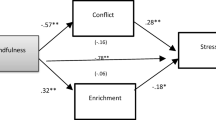Abstract
Using a sample of married individuals employed full-time (N = 1,117), this study examined the mediating effects of constructive and destructive communication between partners on the relationship between work–family conflict and marital satisfaction. Results from structural equation modeling revealed that work–family conflict was significantly and negatively related to marital satisfaction. This relationship became insignificant when constructive and destructive communication were added to the model, evidence for full mediation. This was confirmed with Sobel’s test for mediation. Results suggest that teaching communcation skills may be a potent point of intervention for couples who experience high levels of work–family conflict.



Similar content being viewed by others
References
Allen, T. D., Herst, D. E. L., Bruck, C. S., & Sutton, M. (2000). Consequences associated with work-to-family conflict: A review and agenda for future research. Journal of Occupational Health Psychology, 5, 278–308. doi:10.1037//1076-899B.5.2.278.
Arbuckle, J. L. (2011). IBM SPSS Amos 20 User’s Guide. Armonk, NY: IBM Corporation.
Bakker, A. B., Demerouti, E., & Burke, R. (2009). Workaholism and relationship quality: A spillover–crossover perspective. Journal of Occupational Health Psychology, 14, 23–33. doi:10.1037/a0013290.
Birditt, K. S., Brown, E., Orbuch, T. L., & McIlvane, J. M. (2010). Marital conflict behaviors and implications for divorce over 16 years. Journal of Marriage and Family, 72, 1188–1204. doi:10.1111/j.1741-3737.2010.00758.x.
Brock, R. L., & Lawrence, E. (2008). A longitudinal investigation of stress spillover in marriage: Does spousal support adequacy buffer the effects? Journal of Family Psychology, 22, 11–20. doi:10.1037/0893-3200.22.1.11.
Bui, K.-V. T., Peplau, L. A., & Hill, C. T. (1996). Testing the Rusbult model of relationship commitment and stability in a 15-year study of heterosexual couples. Personality and Social Psychology Bulletin, 22, 1244–1257. doi:10.1177/01461672962212005.
Busby, D. M., Holman, T. B., & Taniguchi, N. (2001). RELATE: Relationship evaluation of the individual, family, cultural, and couple contexts. Family Relations, 50, 308–316. doi:10.1111/j.1741-3729.2001.00308.x.
Busby, D. M., Ivey, D. C., Harris, S. M., & Ates, C. (2007). Self-directed, therapist-directed, and assessment-based interventions for premarital couples. Family Relations, 56, 279–290. doi:10.1111/j.1741-3729.2007.00459.x.
Byron, K. (2005). A meta-analytic review of work–family conflict and its antecedents. Journal of Vocational Behavior, 67, 169–198. doi:10.1016/j.jvb.2004.08.009.
Dehle, C., Larsen, D., & Landers, J. E. (2001). Social support in marriage. The American Journal of Family Therapy, 29, 307–324. doi:10.1080/01926180126500.
Doumas, D. M., Margolin, G., & John, R. S. (2003). The relationship between daily marital interaction, work, and health-promoting behaviors in dual-earner couples. Journal of Family Issues, 24, 3–20. doi:10.1177/0192513X02238518.
Eby, L. T., Casper, W. J., Lockwood, A., Bordeaux, C., & Brinely, A. (2005). Work and family research in IO/OB: Content analysis and review of the literature (1980–2002). Journal of Vocational Behavior, 66, 124–197. doi:10.1016/j.jvb.2003.11.003.
Feeney, J. A. (1994). Attachment style, communication patterns, and satisfaction across the life cycle of marriage. Personal Relationships, 1, 333–348. doi:10.1111/j.1475-6811.1994.tb00069.x.
Ford, M. T., Heinen, B. A., & Langkamer, K. L. (2007). Work and family satisfaction and conflict: A meta-analysis of cross-domain relations. Journal of Applied Psychology, 92, 57–80. doi:10.1037/0021-9010.92.1.57.
Galambos, N. L., & Walters, B. J. (1992). Work hours, schedule inflexibility, and stress in dual-earner spouses. Canadian Journal of Behavioural Science, 24, 290–302. doi:10.1037/h0078743.
Gardner, B. C., Busby, D. M., & Brimhall, A. S. (2007). Putting emotional reactivity in its place? Exploring family-of-origin influences on emotional reactivity, conflict, and satisfaction in premarital couples. Contemporary Family Therapy, 27, 113–127. doi:10.1007/s10591-007-9039-x.
Goodman, K., & Heaton, T. B. (1986). LDS Church members in the U.S. and Canada: A demographic profile. AMCAP Journal, 12(1), 88–107.
Gottman, J. M. (1994). What predicts divorce? The relationship between marital processes and marital outcomes. Hillsdale, NJ: Laurence Erlbaum Associates, Publishers.
Gottman, J. M. (1999). The marriage clinic: A scientifically based marital therapy. New York, NY: W.W. Norton & Company Inc.
Gottman, J. M., & Levenson, R. W. (1992). Marital processes predictive of later dissolution: Behavior, physiology, and health. Journal of Personality and Social Psychology, 63, 221–233. doi:10.1037/0022-3514.63.2.221.
Green, S. G., Schaefer, R. A. B., MacDermid, S. M., & Weiss, H. M. (2011). Partner reactions to work-to-family conflict: Cognitive appraisal and indirect crossover in couples. Journal of Management, 37, 744–769. doi:10.1177/0149206309349307.
Greenhaus, J. H., & Beutell, N. J. (1985). Sources of conflict between work and family roles. The Academy of Management Review, 10(1), 76–88.
Hancock, G. R., & Liu, M. (2012). Bootstrapping standard errors and data-model fit statistics in structural equation modeling. In R. H. Hoyle (Ed.), Handbook of structural equation modeling (pp. 296–306). New York, NY: The Guilford Press.
Hawkins, D. H., & Booth, A. (2005). Unhappily ever after: Effects of long-term, low-quality marriages on well-being. Social Forces, 84, 451–471.
Henderson-King, D. H., & Veroff, J. (1994). Sexual satisfaction and marital well-being in the first years of marriage. Journal of Social and Personal Relationships, 11, 509–534. doi:10.1177/0265407594114002.
Hill, E. J. (2005). Work–family facilitation and conflict, working fathers and mothers, work–family stressors and support. Journal of Family Issues, 26, 793–819. doi:10.1177/0192513X05277542.
Hill, E. J., Fellows, K. J., Chiu, H-.Y., & Hawkins, A. J. (2011, August). Work–family conflict and couple relationship quality: A meta-analytic study. Poster session presented at the meeting of the American Psychological Association, Washington, D.C.
Holman, T. B. (Ed.). (2001). Premarital prediction of marital quality or breakup: Research, theory, and practice. New York: Kluwer Academic/Plenum.
Holman, T. B., Busby, D. M., Doxey, C., Klein, D. M., & Loyer-Carlson, V. (1997). The RELATionship evaluation. Provo, UT: Center for Family Studies.
Ilies, R., Wilson, K. S., & Wagner, D. T. (2009). The spillover of daily job satisfaction onto employees’ family lives: The facilitating role of work–family integration. Academy of Management Journal, 52, 87–102.
Jackson, J. B. (2009). Premarital couple predictors of marital relationship quality and stability: A meta-analytic study. (Doctoral dissertation). Available from Proquest Dissertations and Theses database (UMI No. 3380523).
Jacob, J. I., Allen, S., Hill, E. J., Mead, N. L., & Ferris, M. (2008). Work interference with dinnertime as a mediator and moderator between work hours and work and family outcomes. Family and Consumer Sciences Research Journal, 36, 310–327. doi:10.1177/1077727X08316025.
Johnson, M. D., Cohan, C. L., Davila, J., Lawrence, E., Rogge, R. B., & Karney, B. R. (2005). Problem-solving skills and affective expressions as predictors of change in marital satisfaction. Journal of Counseling and Clinical Psychology, 73, 15–27. doi:10.1037/0022-006X.73.1.15.
Jones, B. L., Scoville, D. P., Hill, E. J., Childs, G., Leishman, J. M., & Nally, K. S. (2008). Perceived versus used workplace flexibility in Singapore: Predicting work–family fit. Journal of Family Psychology, 22, 774–783. doi:10.1037/a0013181.
Judge, T. A., Ilies, R., & Scott, B. A. (2006). Work–family conflict and emotions: Effects at work and at home. Personnel Psychology, 59, 779–814. doi:10.1111/j.1744-6570.2006.00054.x.
Kinnunen, U., & Mauno, S. (1999). The effects of job stressors on marital satisfaction in Finnish dual-earner couples. Journal of Organizational Behavior, 20, 879–895. doi:10.1002/(SICI)1099-1379(199911)20:6<879:AID-JOB982>3.0.CO;2-2.
Larson, J. H., & Holman, T. B. (1994). Premarital predictors of marital quality and stability. Family Relations, 43, 228–237.
Lewis, R. A., & Spanier, G. B. (1979). Theorizing about the quality and stability of marriage. In W. R. Burr, R. Hill, F. I. Nye, & I. L. Reiss (Eds.), Contemporary theories about the family (Vol. 1, pp. 268–294). New York, NY: Free Press.
Macewen, K. E., & Barling, J. (1988). Interrole conflict, family support and marital adjustment of employed mothers: A short term, longitudinal study. Journal of Organizational Behavior, 9, 241–250. doi:10.1002/job.4030090304.
Matthews, L. S., Conger, R. D., & Wickrama, K. A. S. (1996). Work–family conflict and marital quality: Mediating processes. Social Psychology Quarterly, 59, 62–79.
McCubbin, H., & Patterson, J. (1983). The family stress process: The double ABCX model of family adjustment and adaptation. Marriage and Family Review, 6, 7–37. doi:10.1300/J002v06n01_02.
Michel, J. S., Mitchelson, J. K., Kotrba, L. M., LeBreton, J. L., & Baltes, B. B. (2009). A comparative test of work–family conflict models and critical examination of work–family linkages. Journal of Vocational Behavior, 74, 199–218. doi:10.1016/j.jvb.2008.12.005.
Minnotte, K. L., Stevens, D. P., Minnotte, M. C., & Kiger, G. (2007). Emotion-work performance among dual-earner couples: Testing four theoretical perspectives. Journal of Family Issues, 28, 773–793. doi:10.1177/0192513X07299676.
Perrone, K. M., & Worthington, E. L. (2001). Factoring influencing ratings of marital quality by individuals within dual-career marriages: A conceptual model. Journal of Counseling Psychology, 48, 3–9. doi:10.1037W0022-0167.48.1.3.
Preacher, K. J., & Hayes, A. F. (2004). SPSS and SAS procedures for estimating indirect effects in simple mediation models. Behavior Research Methods, Instruments, & Computers, 36, 717–731.
Repetti, R. L. (1989). Effects of daily workload on subsequent behavior during marital interaction: The roles of social withdrawal and spouse support. Journal of Personality and Social Psychology, 57, 651–659. doi:10.1037/0022-3514.57.4.651.
Risch, G. S., Riley, L. A., & Lawler, M. G. (2003). Problematic issues in the early years of marriage: Content for premarital education. Journal of Psychology and Theology, 31, 253–269.
Sandberg, J. G., Yorgason, J. B., Miller, R. B., & Hill, E. J. (2012). Family-to-work spillover in Singapore: Marital distress, physical and mental health, and work satisfaction. Family Relations, 61, 1–15. doi:10.1111/j.1741-3729.2011.00682.x.
Schulz, M. S., Cowan, P. A., Cowan, C. P., & Brennan, R. T. (2004). Coming home upset: Gender, marital satisfaction, and the daily spillover of workday experience into couple interactions. Journal of Family Psychology, 18, 250–263. doi:10.1037/0893-3200.18.1.250.
Shumway, S., Wampler, R., Dersch, C., & Arredondo, R. (2004). A place for marriage and family services in employee assistance programs (EAPs): A survey of EAP client problems and needs. Journal of Marital & Family Therapy, 30, 71–79. doi:10.1111/j.1752-0606.2004.tb01223.x.
Siffert, A., & Schwarz, B. (2011). Spouses’ demand and withdrawal during marital conflict in relation to their subjective well-being. Journal of Social and Personal Relationships, 28, 262–277. doi:10.1177/0265407510382061.
Sobel, M. E. (1982). Asymptotic confidence intervals for indirect effects in structural equations models. Sociological Methodology, 13, 290–312. doi:10.3758/BRM.40.3.879.
Stanley, S. M., Blumberg, S. L., & Markman, H. J. (1999). Helping couples fight for their marriages: The PREP approach. In R. Berger & M. T. Hannah (Eds.), Preventive approaches in couples therapy (pp. 279–303). Philadelphia, PA, US: Brunner/Mazel.
Swanson, V., & Power, K. G. (1999). Stress, satisfaction and role conflict in dual-doctor partnerships. Community, Work & Family, 2, 67–88. doi:10.1080/13668809908414250.
Waite, L. J., & Gallagher, M. (2000). The case for marriage: Why married people are happier, healthier, and better off financially. New York, NY: Double Day.
Wallerstein, J. S., Lewis, J. M., & Blakeslee, S. (2000). The unexpected legacy of divorce: A 25 year landmark study. New York, NY: Hyperion.
Weigel, D. J., & Ballard-Reisch, D. S. (2008). Relational maintenance, satisfaction and commitment in marriages: An actor-partner analysis. Journal of Family Communication, 8, 212–229. doi:10.1080/15267430802182522.
Wu, M., Chang, C.-C., & Zhuang, W.-L. (2010). Relationships of work–family conflict with business and marriage outcomes in Taiwanse copreneurial women. The International Journal of Human Resource Management, 21, 742–753. doi:10.1080/09585191003658912.
Author information
Authors and Affiliations
Corresponding author
Rights and permissions
About this article
Cite this article
Carroll, S.J., Hill, E.J., Yorgason, J.B. et al. Couple Communication as a Mediator Between Work–Family Conflict and Marital Satisfaction. Contemp Fam Ther 35, 530–545 (2013). https://doi.org/10.1007/s10591-013-9237-7
Published:
Issue Date:
DOI: https://doi.org/10.1007/s10591-013-9237-7




